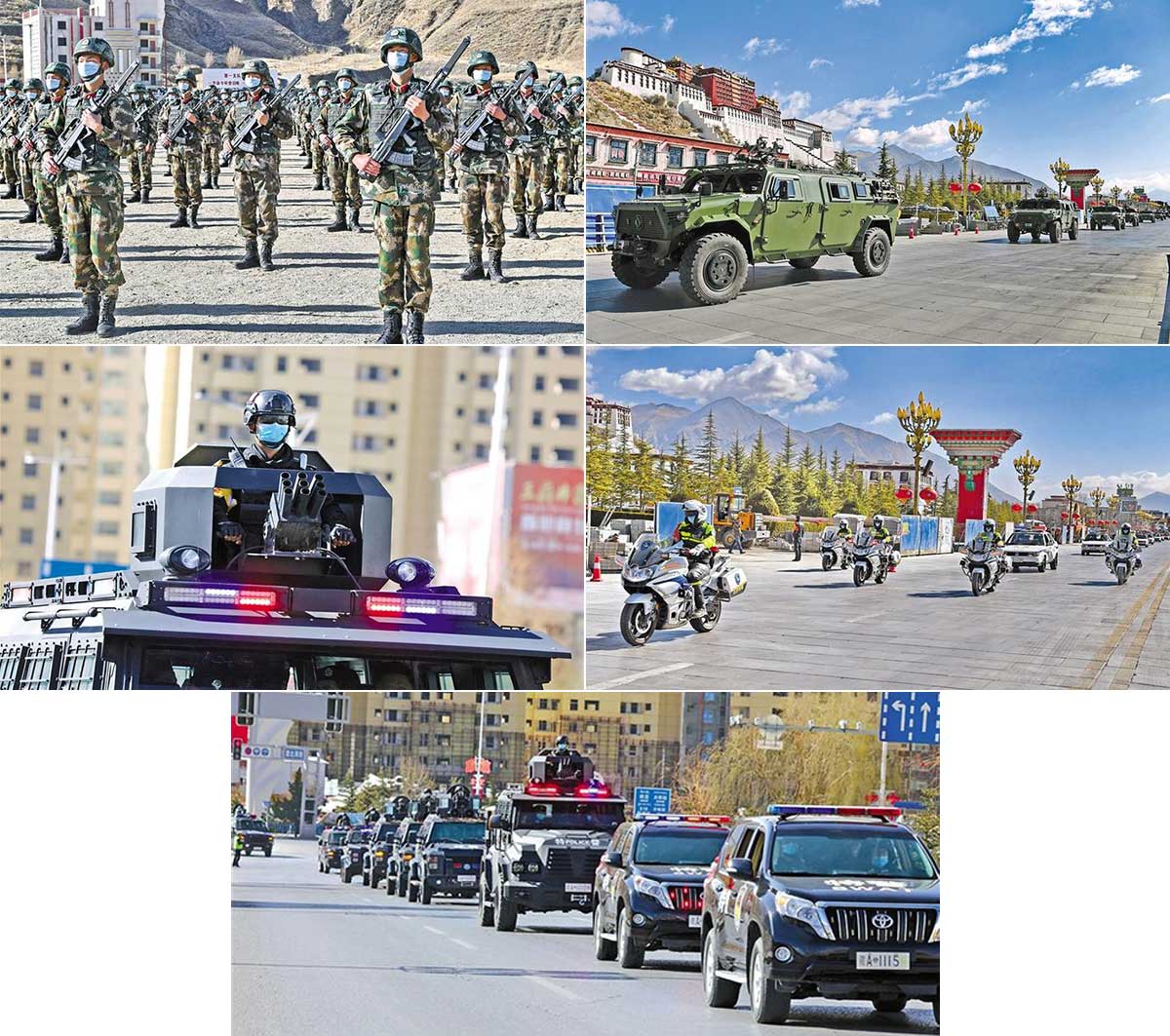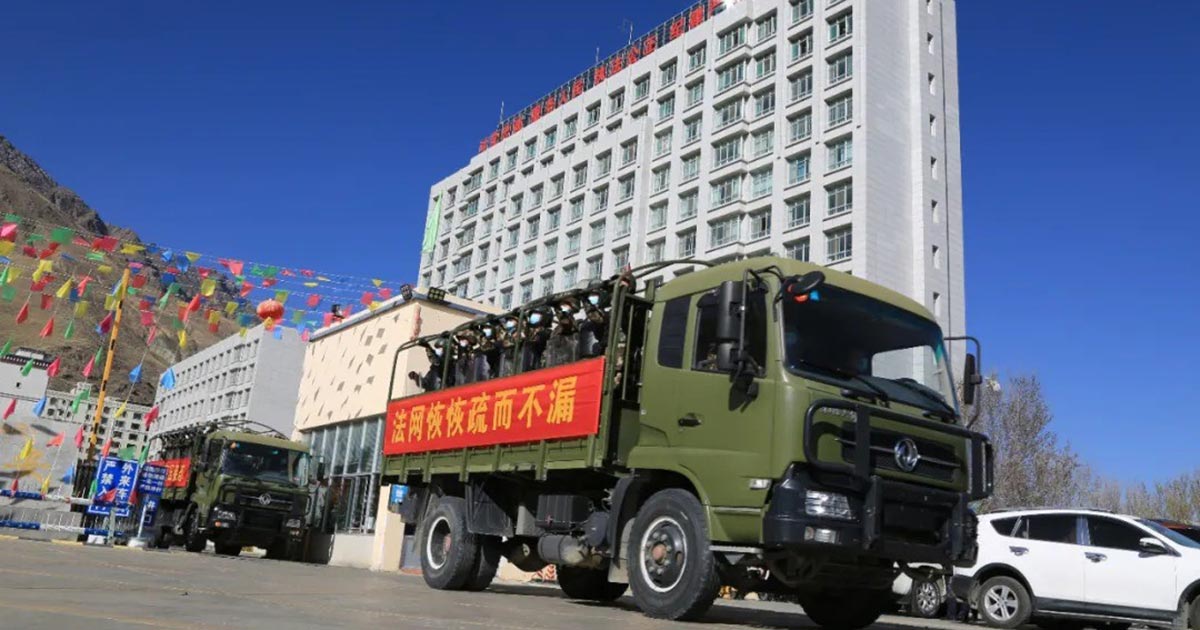China recently held the annual “two sessions” of its national legislature, the National People’s Congress, and the political advisory body the Chinese People’s Political Consultative Conference from March 4 to 11, 2021. The annual meeting is important for understanding political plans and priorities, and this year’s meeting was especially significant for releasing preliminary details of China’s 14th Five-Year Plan and beyond.
The Tibet Autonomous Region delegation to the sessions included Wu Yingjie, party secretary of the TAR; Lobsang Gyaltsen, chairman of the TAR People’s Congress; and Chi Dralha, chairman of the TAR government. The TAR delegation comprised 16 deputies, three non-voting attendees and three observers.
The TAR only covers about half of Tibet, which China annexed more than 60 years ago. Tibetan delegates from other Tibetan areas included Tashi Dorje (Chinese: Zhaxi Duojie), head of the performing arts troupe in Yushu, Qinghai, and Dhadak Doring Thupten Gyatso (Dazha Duoring Tudan Jiacuo), vice chair of the CPPCC chapter in Ngaba (Aba) Tibetan & Qiang Autonomous Prefecture.
14th Five-Year Plan
The 14th Five-Year Plan was dominant during the meetings this year as China’s political elites set targets and objectives for the next five years (2021-2025), as well as long-range objectives through 2035. The centrally mandated 14th Five-Year Plan incorporates broad plans for Tibet.
The meeting indicated that China will continue along its current path to build a “Modern Socialist Country.” For Tibetans, this means the current assimilationist policies will continue to accelerate. The meetings reasserted the language of “modernizing Tibet,” “Sinicizing” religion, “resisting foreign interference” in internal affairs, and “maintaining stability” with a strong military approach.
While the specific details of the 14th plan for the TAR and Tibetan areas in Sichuan, Gansu, Qinghai and Yunnan provinces are expected sometime in late 2021 or early 2022, the central goal to transform China as a “Modern Socialist Country” by the middle of this century invariably affects Tibet and Tibetans in all respects.
Broadly, it appears that the 14th Five-Year Plan and the long-range objectives will lead to:
- The continued displacement of Tibetans in Tibet in the name of “poverty alleviation” and ecological conservation
- Tibetans losing their traditional lifestyle under Beijing’s urbanization and rural revitalization plan
- A large influx of Chinese tourists to Tibet as the central government pushes for domestic consumption as part of a “dual circulation” strategy to steady plateauing economic growth
- Further militarization to strengthen China’s border areas
- More large-scale infrastructure in the name of developing the western areas of the country
In his government work report during the opening of the National People’s Congress on March 5, Chinese Premier Li Keqiang extolled the “historic new achievement” of the goals and tasks set for “poverty alleviation” in the 13th Five Year Plan. While the premier provided impressive figures for poverty eradication in his speech, the methods and effects of the government’s relocating of millions of Tibetans for “poverty alleviation” (628,000 in the TAR alone seemingly during the 13th Five-Year Plan) is left unstated. The coercive relocation of millions of “poor” rural Tibetans has not only led to their displacement from their ancestral lands but converted their proud self-sufficiency into dependence on the Chinese state and manufactured political gratitude to the Chinese Communist Party for its continued subsidies.
Sinicization of Tibet
While the premier’s government work report affirmed the implementation of “the Party’s basic policy on religious affairs, and work to guide religions in adapting to socialist society,” the CCP-installed Panchen Lama, Gyaltsen Norbu—who is a member of the Standing Committee of the Chinese People’s Political Consultative Conference, vice president of the Chinese Buddhist Association and president of the TAR branch of the Chinese Buddhist Association—reportedly expressed his support to the state leadership’s policies. A longer report in Chinese state media quotes him as saying, “Tibetan Buddhism is constantly moving in the direction of Sinicization under the conditions of adapting to the socialist society with Chinese characteristics … and that from an objective point of view, Sinicization of Tibetan Buddhism is the only way forward for the development of Tibetan Buddhism.” This is consistent with the Chinese Communist Party’s call for the Sinicization of all religions, including Tibetan Buddhism, at the 19th Party Congress in 2017, and the subsequent 2019 five-year plan to Sinicize Buddhism launched by the state-backed Chinese Buddhist Association.
Sinicization is a campaign by the Chinese government to bring all aspects of society under the control of the Chinese government. In Tibet, Sinicization includes giving the government total authority over Tibetan Buddhism and attempting to eliminate Tibetans’ unique religious, linguistic and cultural identity.
Similarly, state media reported that one of the delegates of the Political Consultative Conference, Thupten Khedup, a professor at Tibet University, “proposed” that Beijing should promote “red tourism” resources in the “ethnic regions in the frontier.” He said this will “promote members of all ethnic groups to identify with the common identity of the Chinese nation.” Red tourism is a propaganda initiative that encourages Chinese people to visit places of historical significance to the CCP.
The Party reacts to US legislation on Tibet
In his opening speech on March 4, the chairman of the conference, Wang Yang, stressed the party’s denunciation of US legislation in support of the rights of Tibetans, Uyghurs and democracy activists in Hong Kong. Speaking of the legislation to conference members, Wang Yang remarked, “we denounced in the strongest terms US legislation concerning Xinjiang, Tibet, and Hong Kong.”
While human rights are universal and indivisible, leaders in China have consistently maintained that its record of human rights abuses is an internal matter according to China’s position of the culturally specific relativity of human rights. China has consistently argued that national sovereignty outranks all other international law, making any assessment of human rights into an interference in China’s internal affairs and exclusive jurisdiction. During the “two sessions,” the principle of non-interference in internal matters was stressed prominently to shield China’s rights abuses of Tibetans, Uyghurs, Hong Kong democracy activists, etc.
Xi Jinping recalls his visit to Yushu
During the National People’s Congress, Chinese president Xi Jinping participated in the deliberations of the Qinghai delegation on March 7. Not wasting an opportunity to portray the party’s benevolence over the earthquake that struck Yushu Tibetans in April 2010, he recalled his visit to Yushu after the earthquake and his “concerns” for the Tibetans living there. Underscoring the party’s benevolence and its poverty alleviation program, Xi remarked, “At that time, I went to understand what the people live on. Some people went up the mountains to dig cordyceps. After a few days, returning to home was returning to a poor life. Through nationwide poverty eradication … people have seen the care and strength of the party through earthquake relief and poverty alleviation in achieving results to tackle tough problems. For that they [Tibetans] sing folk songs for the party from their hearts.”
However, Tibetans in Yushu raised many concerns with the reconstruction plan after the earthquake. Hundreds of Tibetans demonstrated in Kyegu town in Yushu a year after the earthquake, holding banners and signs with slogans saying, “Help for the Yushu disaster area should put ordinary people’s benefits first. This concerns people’s lives. Reasonably plan the land of our lives.” The protests have resulted from local concerns over the government’s reconstruction policies, which exclude Tibetans from the planning process, and the allocation of land. Some Tibetans said their hometown was being rebuilt from the original thriving, traditional trading hub for Tibetan pastoralists into a Chinese tourist hub.
Xi, stressing Beijing’s recognition of the Tibetan Plateau as critical for China’s “ecological security” and sustainable development, also instructed the Qinghai delegation to “undertake the major mission of maintaining ecological security, protecting the source of the Three Rivers, and protecting the ‘Chinese Water Tower.’” However, in recent years, thousands of Tibetan herders have been sedentarized to “protect” the source of Three Rivers: the Machu (Yellow), Drichu (Yangtze) and Dzachu (Mekong). China’s construction of a cascade of dams on rivers originating from Tibet to harness hydropower and divert water to mainland Chinese cities has not only led to sedentarization of Tibetan pastoralists under the pretext of “ecology conservation,” but also denied access to Tibetan rivers to people in downstream countries in South and Southeast Asia.
Security drills in Tibet
Beijing maintains tight security in Tibet to achieve its policy goals. As in the past year, this year, too, China’s Minister for Public Security and State Councilor Zhao Kezhi attended the deliberations of the TAR delegation during the 13th National People’s Congress.
Owing to sensitivity of multiple dates and events this year—the two sessions, Tibetan Uprising Day, the 100th anniversary of the Communist Party, the 70th anniversary of the “peaceful liberation of Tibet”—security is tight in Tibet. To deter Tibetans from expressing their grievances against Chinese rule on the 62nd Tibetan National Uprising Day, which coincided with the second-to-last day of the 13th Congress, a TAR and Lhasa City Stability Maintenance force mobilization meeting was held in Lhasa, Tibet’s capital, on March 10. The Stability Maintenance force comprises of troops from the People’s Liberation Army, People’s Armed Police, Public Security Bureau officers and Fire Brigade. The security troops were ordered to “Be Loyal to the Party, keep mission in mind, fight terrorism, control violence, stabilize the border, strengthen the foundation, unite the people, and resolutely win the battle to maintain stability.”
Following the meeting, a security drill was conducted in Lhasa the same day, and simultaneous drills were also conducted in all cities and prefectures in the TAR to mark Tibet entering the phase of stability maintenance to “resolutely implement the decision of General Secretary Xi Jinping and the Party Central Committee.”

Security drills in Lhasa on March 10, 2021. (Source: People’s Daily Online)

“There is no escape from the long arm of the law” reads the red banner on security trucks carrying troops in the streets of Lhokha (Chinese: Shannan) City in March 2021. (Photo via Radio Free Asia)

Security armored vehicles on standby in front of Jokhang Temple in early March 2021. (Photo: RFA)

